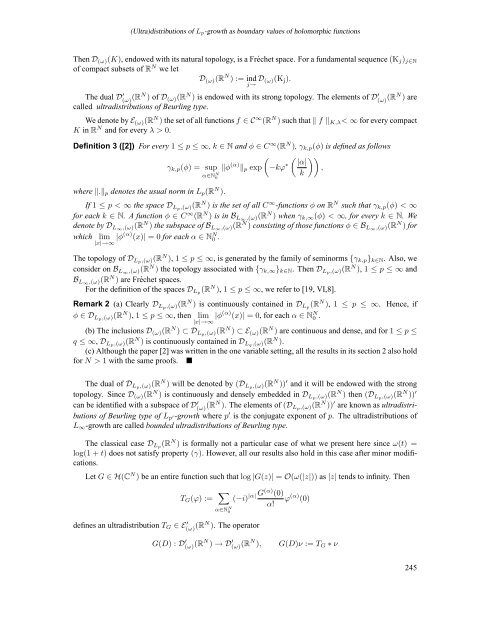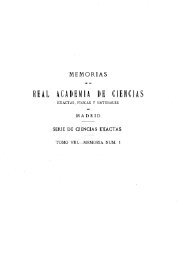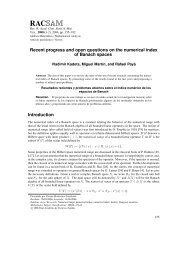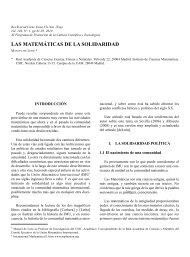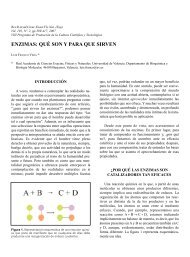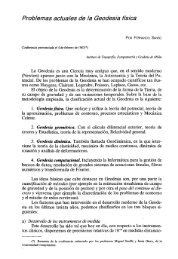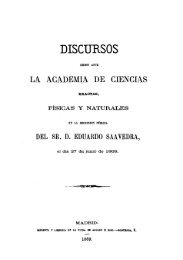Holomorphic Functions
Holomorphic Functions
Holomorphic Functions
Create successful ePaper yourself
Turn your PDF publications into a flip-book with our unique Google optimized e-Paper software.
(Ultra)distributions of L p-growth as boundary values of holomorphic functionsThen D (ω) (K), endowed with its natural topology, is a Fréchet space. For a fundamental sequence (K j ) j∈Nof compact subsets of R N we letD (ω) (R N ) := indj→ D (ω)(K j ).The dual D ′ (ω) (RN ) of D (ω) (R N ) is endowed with its strong topology. The elements of D ′ (ω) (RN ) arecalled ultradistributions of Beurling type.We denote by E (ω) (R N ) the set of all functions f ∈ C ∞ (R N ) such that ‖ f ‖ K,λ < ∞ for every compactK in R N and for every λ > 0.Definition 3 ([2]) For every 1 ≤ p ≤ ∞, k ∈ N and φ ∈ C ∞ (R N ), γ k,p (φ) is defined as follows( ( )) |α|γ k,p (φ) = sup ‖φ (α) ‖ p exp −kϕ ∗ ,α∈N kN0where ‖.‖ p denotes the usual norm in L p (R N ).If 1 ≤ p < ∞ the space D Lp,(ω)(R N ) is the set of all C ∞ -functions φ on R N such that γ k,p (φ) < ∞for each k ∈ N. A function φ ∈ C ∞ (R N ) is in B L∞,(ω)(R N ) when γ k,∞ (φ) < ∞, for every k ∈ N. Wedenote by D L∞,(ω)(R N ) the subspace of B L∞,(ω)(R N ) consisting of those functions φ ∈ B L∞,(ω)(R N ) forwhich lim|x|→∞ |φ(α) (x)| = 0 for each α ∈ N N 0 .The topology of D Lp,(ω)(R N ), 1 ≤ p ≤ ∞, is generated by the family of seminorms {γ k,p } k∈N . Also, weconsider on B L∞,(ω)(R N ) the topology associated with {γ k,∞ } k∈N . Then D Lp,(ω)(R N ), 1 ≤ p ≤ ∞ andB L∞,(ω)(R N ) are Fréchet spaces.For the definition of the spaces D Lp (R N ), 1 ≤ p ≤ ∞, we refer to [19, VI,8].Remark 2 (a) Clearly D Lp,(ω)(R N ) is continuously contained in D Lp (R N ), 1 ≤ p ≤ ∞. Hence, ifφ ∈ D Lp,(ω)(R N ), 1 ≤ p ≤ ∞, then lim|x|→∞ |φ(α) (x)| = 0, for each α ∈ N N 0 .(b) The inclusions D (ω) (R N ) ⊂ D Lp,(ω)(R N ) ⊂ E (ω) (R N ) are continuous and dense, and for 1 ≤ p ≤q ≤ ∞, D Lp,(ω)(R N ) is continuously contained in D Lq,(ω)(R N ).(c) Although the paper [2] was written in the one variable setting, all the results in its section 2 also holdfor N > 1 with the same proofs. The dual of D Lp,(ω)(R N ) will be denoted by (D Lp,(ω)(R N )) ′ and it will be endowed with the strongtopology. Since D (ω) (R N ) is continuously and densely embedded in D Lp,(ω)(R N ) then (D Lp,(ω)(R N )) ′can be identified with a subspace of D ′ (ω) (RN ). The elements of (D Lp,(ω)(R N )) ′ are known as ultradistributionsof Beurling type of L p ′-growth where p ′ is the conjugate exponent of p. The ultradistributions ofL ∞ -growth are called bounded ultradistributions of Beurling type.The classical case D Lp (R N ) is formally not a particular case of what we present here since ω(t) =log(1 + t) does not satisfy property (γ). However, all our results also hold in this case after minor modifications.Let G ∈ H(C N ) be an entire function such that log |G(z)| = O(ω(|z|)) as |z| tends to infinity. ThenT G (ϕ) := ∑α∈N N 0defines an ultradistribution T G ∈ E ′ (ω) (RN ). The operator(−i) |α| G(α) (0)ϕ (α) (0)α!G(D) : D ′ (ω) (RN ) → D ′ (ω) (RN ),G(D)ν := T G ∗ ν245


